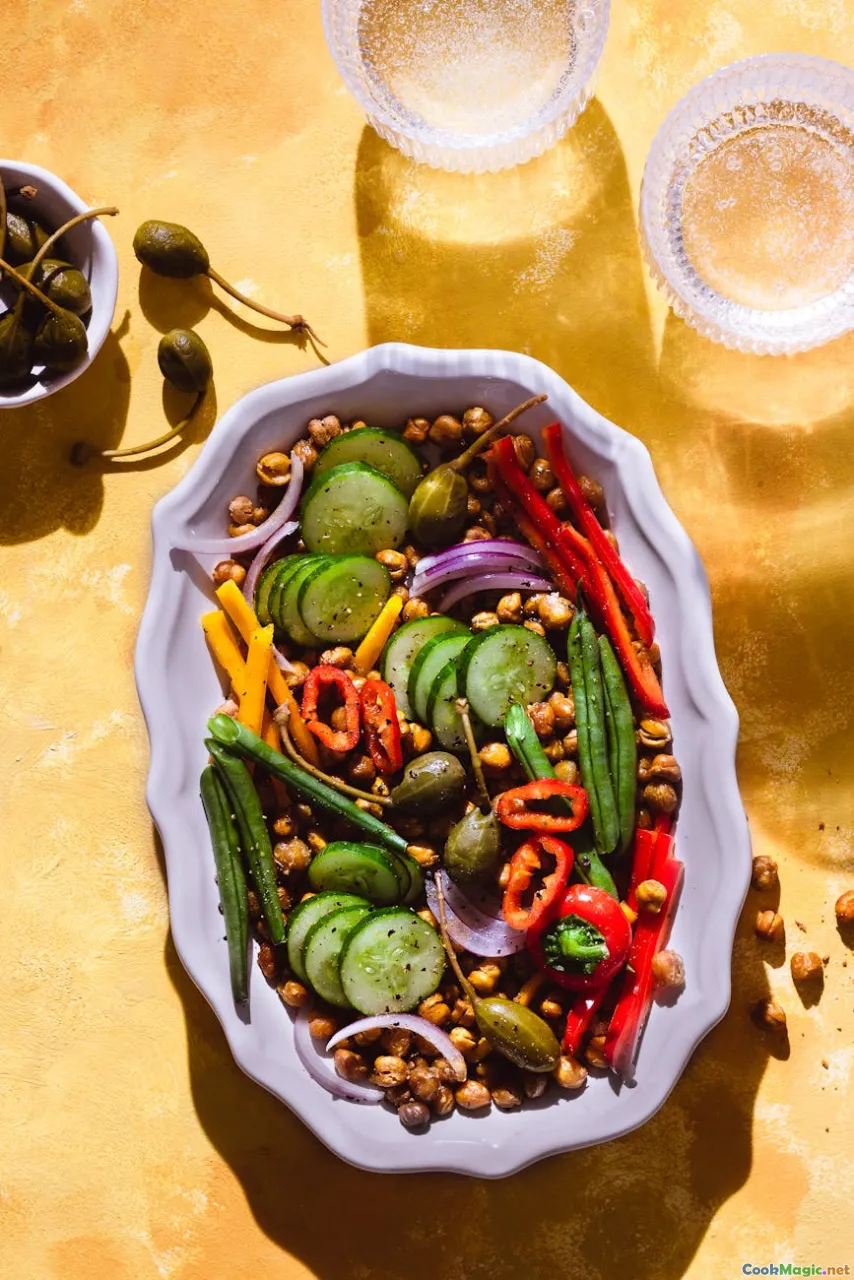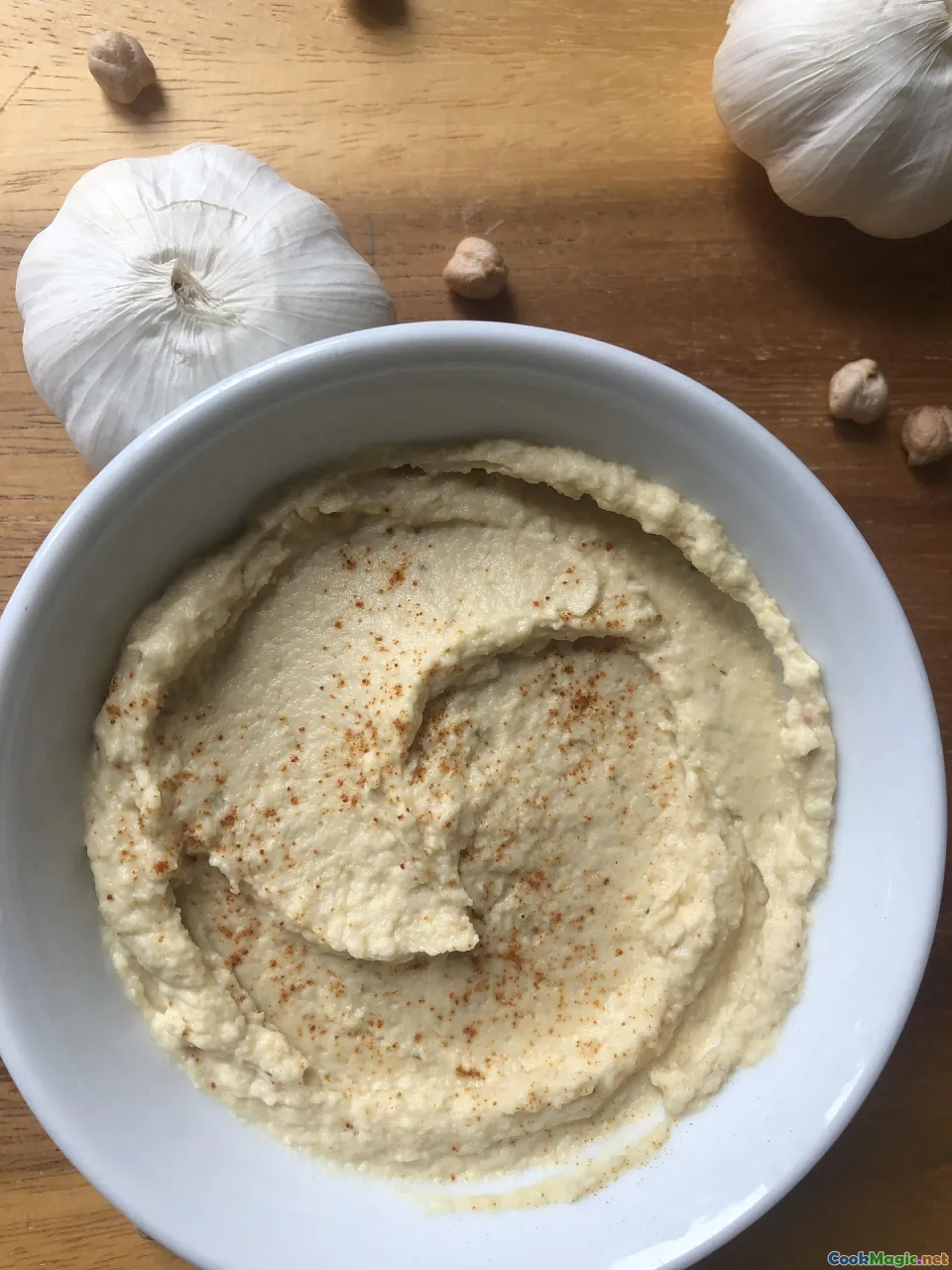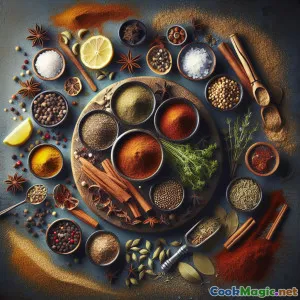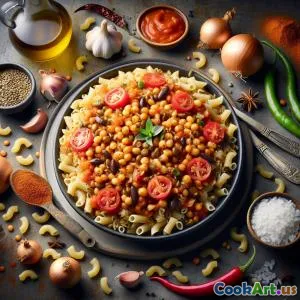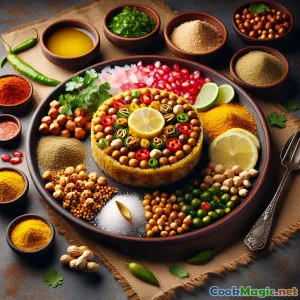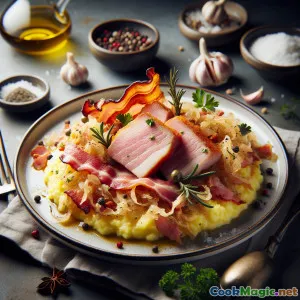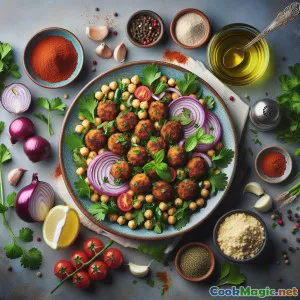
Kıtır Kıtır İskenderiye Nohutlu Köfte Lezzeti
(Crispy Alexandrian Chickpea Kofta Delight)
(0 Yorumlar)0
263
Ekim 01, 2025
Bir Sorun Bildir
Malzemeler
-
400 grams Nohut (pişmiş veya konserve)
(Drained and rinsed if canned)
-
1 medium Kırmızı soğan
(Kaba doğranmış)
-
3 pieces Sarımsak dişleri
(Kıyılmış)
-
25 grams Taze maydanoz
(İnce doğranmış)
-
10 grams Taze nane
(İnce doğranmış)
-
2 teaspoons Kimyon tozu
(Taze öğütülmüş önerilir)
-
1 teaspoon Kişniş tozu
-
1 teaspoon Paprika
(Smoked optional)
-
0.5 teaspoon Toz tarçın
-
1.5 teaspoons Deniz tuzu
-
0.5 teaspoon Özütülmüş karabiber
(Damak tadına göre)
-
3 tablespoons Zeytinyağı
(Plus more for frying)
-
50 grams Nohut unu (besan)
(Adds binding; sub with plain flour if needed)
-
1 teaspoon Limon kabuğu
-
0.5 teaspoon Kabartma tozu
(Ensures a light texture)
-
1 small Domates
(Çekirdeksiz ve ince doğranmış)
-
2 tablespoons Susam tohumları
(For crunchy coating)
(Drained and rinsed if canned)
(Kaba doğranmış)
(Kıyılmış)
(İnce doğranmış)
(İnce doğranmış)
(Taze öğütülmüş önerilir)
(Smoked optional)
(Damak tadına göre)
(Plus more for frying)
(Adds binding; sub with plain flour if needed)
(Ensures a light texture)
(Çekirdeksiz ve ince doğranmış)
(For crunchy coating)
Besin Değerleri
- Porsiyon: 4
- Porsiyon Boyutu: 3 kofta (about 180g)
- Calories: 410 kcal
- Carbohydrates: 0 g
- Protein: 15 g
- Fat: 14 g
- Fiber: 13 g
- Sugar: 6 g
- Sodium: 875 mg
- Cholesterol: 0 mg
- Calcium: 120 mg
- Iron: 3.2 mg
Talimatlar
-
1 - Prepare Chickpeas:
If using canned chickpeas, drain and rinse thoroughly. Pat dry with paper towels to remove excess moisture.
-
2 - Pulse Ingredients:
In a food processor, combine chickpeas, red onion, garlic, parsley, optional mint, cumin, coriander, cinnamon, salt, and pepper. Pulse until a coarse, mealy mixture forms. Avoid overprocessing—mixture should not be a paste.
-
3 - Mix and Bind:
Transfer mixture to a bowl. Stir in gram flour, paprika, lemon zest, baking powder, chopped tomato, and 1 tbsp olive oil. Mix well until mixture holds together. Add more flour if it’s too moist.
-
4 - Form Kofta:
With oiled hands, divide mixture into 12 even portions and shape into oval balls or cylindrical kofta. Roll in sesame seeds if desired.
-
5 - Chill Kofta:
Place shaped kofta on a tray and refrigerate for at least 10 minutes to firm up (optional but recommended for easy shaping and frying).
-
6 - Cook Kofta:
Heat remaining olive oil in a large nonstick skillet over medium heat. Fry kofta on all sides until golden (about 3-4 mins per side). Alternatively, brush with oil and bake at 200°C for 15–20 minutes, turning halfway for even color.
-
7 - Serve:
Transfer kofta to a serving plate. Enjoy with tahini sauce, fresh salad, and flatbread for a complete Alexandrian meal.
If using canned chickpeas, drain and rinse thoroughly. Pat dry with paper towels to remove excess moisture.
In a food processor, combine chickpeas, red onion, garlic, parsley, optional mint, cumin, coriander, cinnamon, salt, and pepper. Pulse until a coarse, mealy mixture forms. Avoid overprocessing—mixture should not be a paste.
Transfer mixture to a bowl. Stir in gram flour, paprika, lemon zest, baking powder, chopped tomato, and 1 tbsp olive oil. Mix well until mixture holds together. Add more flour if it’s too moist.
With oiled hands, divide mixture into 12 even portions and shape into oval balls or cylindrical kofta. Roll in sesame seeds if desired.
Place shaped kofta on a tray and refrigerate for at least 10 minutes to firm up (optional but recommended for easy shaping and frying).
Heat remaining olive oil in a large nonstick skillet over medium heat. Fry kofta on all sides until golden (about 3-4 mins per side). Alternatively, brush with oil and bake at 200°C for 15–20 minutes, turning halfway for even color.
Transfer kofta to a serving plate. Enjoy with tahini sauce, fresh salad, and flatbread for a complete Alexandrian meal.
Kıtır Kıtır İskenderiye Nohutlu Köfte Lezzeti :Hakkında Daha Fazlası
Alexandrian Chickpea Kofta: A Vegan Legacy from Egypt's Ancient Shores
Chickpea kofta is rooted in one of the world’s oldest culinary traditions—the vibrant and cosmopolitan fare of Alexandria, Egypt. This coastal city, long a crossroads of trade and cultures, is celebrated for its innovative approach to Mediterranean and Middle Eastern flavors. While 'kofta' is a familiar name across North Africa and West Asia—usually referring to minced meat skewers—this wholly plant-based twist highlights the region’s reverence for pulses such as chickpeas, making it perfect for vegans and vegetarians alike. Plant-based kofta of various sorts have actually been served in parts of Egypt for generations, with protein-rich legumes favored during Lent, Ramadan, or as hearty street food year-round.
The Story & Significance
While Alexandria’s markets may sell both beef or fish kofta, chickpea blends are a longtime staple due to Egypt’s ancient agricultural traditions and Coptic Christian fasting periods. Historically, chickpeas have been applauded not just for their affordability, but for their ability to deliver robust, sustaining protein and wonderful texture. Furthermore, the kofta format makes the most out of local spices like cumin and coriander—which have graced Egyptian trade stalls since the era of pharaohs.
This vegan rendition balances traditional seasonings (cumin, coriander, and cinnamon for warmth) with vibrant pops from fresh herbs: grassy parsley, zesty lemon, and cooling, aromatic mint. Gram flour (besan) serves as a natural binder, creating light and crisp kofta that remain tender inside. Baking powder is an optional secret for achieving fluffiness. Don’t hesitate to make double, as leftovers are just as delicious eaten cold, wrapped in flatbreads with garlic-tahini sauce and sliced vegetables.
Texture, Flavor & Spice
Each bite of the Alexandrian chickpea kofta is a tapestry of savor and texture—the kind plant-powered diets dream of. Eaten hot and fresh for lunch, as part of a meze, or wrapped for grab-and-go lunches, their interior stays moist from fresh onion and chopped tomato (don’t overwork your processor; it’s best when still a little rough). Optional sesame seeds provide a toasted finish and extra crunch worthy of street food snacking.
The classic Egyptian pantry is minimal yet deeply aromatic: cumin is always present—its musky-earth notes a perfect match for chickpeas—balanced by floral coriander and the faintest hint of cinnamon to nod towards the city’s spice-blending history. Use fresh herbs to taste, and consider smoked paprika instead of classic sweet for a hint of sultry aroma.
Preparation Tips & Serving Suggestions
- Moisture control: Always dry chickpeas well to ensure kofta bind and brown. If your mix is sticky, use a bit more gram flour for shaping.
- Binding tips: Gram flour is classic, but plain flour or panko breadcrumbs work well too.
- Kofta shape: Traditionally oval or torpedo-shaped, but round flattened patties can save time.
- Cooking methods: For healthier kofta, bake them. For classic crunch, shallow-fry in plenty of olive oil.
- Serving ideas: Always accompany Alexandrian chickpea kofta with squeeze of lemon, warm flatbreads, and sauces like tahini or a simple cucumber-mint yogurt for non-vegans. After a day cooling in the fridge, they make fantastic additions crumbled on salads or tossed through grain bowls.
Cultural and Historical Insights
Alexandria’s culinary landscape exemplifies the age-old blend of Levantine, Ottoman, and North African flavors, where pulses and dry goods have underpinned cuisine for centuries. Vegan and vegetarian kofta date especially to fasting periods like Lent, when Orthodox Copts are called to avoid any animal products. Even in working-class areas, spiced chickpea balls fed generations as cheap, protein-rich street food, sold hot and fresh, with generous dashes of sumac or pickled turnip on the side.
Kofta recipes include an endless range—meat, vegetables, even salted fish—but the lemony bite and supple texture of Alexandrian chickpea versions are truly special, encapsulating Alexandria’s dynamic meeting place status.
Unique Aspects & Final Thoughts
What distinguishes this recipe? It’s truly fuss-free: canned or freshly cooked chickpeas both work, and most ingredients can be found in a standard supermarket. Plus, unlike typical fried snacks, these kofta freeze exceptionally well and can even be baked for encouraged crunch minus the guilt. Optional herbs and seeds let you jazz them up or pare things back for a minimalist Egyptian taste.
For a glimpse into Alexandria’s iconic foodways—with dual roots in tradition and modern plant-forward movement—these chickpea kofta deliver distinctive flavor, satisfying nutrients, and a hint of sun-soaked Egyptian history in every bite.

